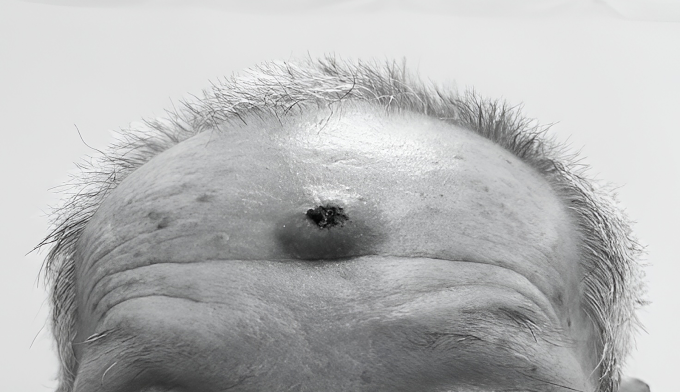Hanoi The rough mass on the forehead of an 82-year-old man recently swelled, became rough, itchy, and oozed fluid. Doctors discovered it was cancer.
He said the mass appeared many years ago but was not unusual, and only swelled up about a year ago.
On May 7, Dr. Pham Duy Linh, Department of Plastic Surgery, Duc Giang General Hospital, said the patient had squamous cell carcinoma of the forehead. This is a case of skin cancer in the early stages and is complicated.
The surgeon removes the entire tumor, then reshapes and transfers a large flap of skin to cover the damaged area. After surgery, the patient must follow the doctor's instructions so that the flap can survive well, heal quickly, and reduce the risk of infection.
Doctors recommend that when there are lumps, moles or unusual skin patches (gray spots, freckles or yellow skin), signs of spreading, developing over time, or becoming rough, you should go for cancer screening.

Unusual rough mass on the patient's forehead. Photo: Provided by the hospital
Squamous cell carcinoma, also called squamous cell cancer, accounts for about 20% of skin cancers. Cancer begins in the flat cells in the outer layer of the epidermis, and often develops in sun-exposed areas such as the face, ears, neck, lips, hands, and on scars or chronic sores.
Squamous cell carcinoma can develop from precancerous skin spots called actinic keratosis. Signs include firm, red bumps on the skin; flat lesions with scaly surfaces; and ulcers that heal or crack.
Factors that increase the risk of squamous cell carcinoma include freckling, frequent sun exposure, a family history of skin cancer, and a personal history of sunburn. People with weakened immune systems and the genetic disorder xeroderma pigmentosum are at increased risk of developing this cancer.
To prevent skin cancer, regularly apply sunscreen to protect your skin. When going out in the sun, wear sunscreen, gloves, and sunglasses to cover and protect your skin and eyes.
Minh An
Source link


![[Photo] Worshiping the Tuyet Son statue - a nearly 400-year-old treasure at Keo Pagoda](/_next/image?url=https%3A%2F%2Fvphoto.vietnam.vn%2Fthumb%2F1200x675%2Fvietnam%2Fresource%2FIMAGE%2F2025%2F12%2F02%2F1764679323086_ndo_br_tempimageomw0hi-4884-jpg.webp&w=3840&q=75)


![[Photo] Parade to celebrate the 50th anniversary of Laos' National Day](/_next/image?url=https%3A%2F%2Fvphoto.vietnam.vn%2Fthumb%2F1200x675%2Fvietnam%2Fresource%2FIMAGE%2F2025%2F12%2F02%2F1764691918289_ndo_br_0-jpg.webp&w=3840&q=75)
































![[Video] Protecting World Heritage from Extreme Climate Change](https://vphoto.vietnam.vn/thumb/402x226/vietnam/resource/IMAGE/2025/12/03/1764721929017_dung00-57-35-42982still012-jpg.webp)































































Comment (0)